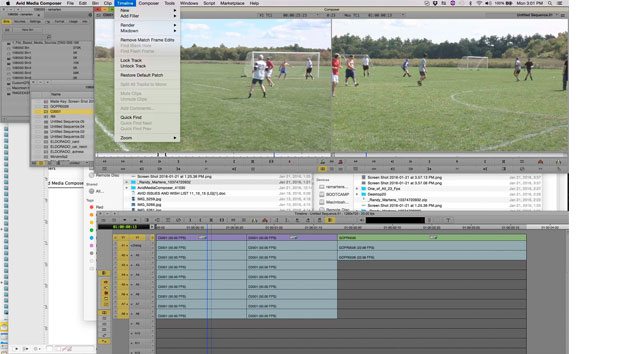It's been a good year for Avid editors, as new versions of Avid Media Composer made high-res workflow a reality on the system, adding custom resolutions that topped out at a massive 8K square: 8192×8192. The latest update, Media Composer 8.5, is more workflow and interface oriented, adding high dynamic range (HDR) color spaces as well as reorganized menus, a better drag-and-drop experience on the timeline, and more.
The New Project dialog now allows editors to select from dozens of color spaces, supporting Dolby Vision, Sony S-Log3, BBC/NHK and ACES profiles. Color transformations are handled automatically once an HDR color space is selected. Avid is recommending DNxHD444 and HQX (10-bit) for HD projects and DNxHR444 and DNxHQX (12-bit) for greater-than-HD resolutions.
Avid says it has restructured menu items in a more logical way, but the new scheme may be tricky for editors to get used to. Avid has included a lengthy table showing exactly where menu options have moved to in the What's New guide [PDF] that goes along with the v8.5 release. This version also allows users to add columns with custom headings to a bin.
Another new feature is described as High-Visibility Timeline Editing. which promises to further modernize the Avid timeline. Now, clips remain visible — including waveforms, if you have them turned on — but become transparent as you drag them around on the timeline, allowing you to keep an eye on the layout of your timeline while you're dragging, and to line up clips based on visible waveform shapes. Also new is the ability to create a new track by dragging a clip up or down and dropping it outside the existing track structure.
Trimming has been improved, with the ability to trim with Sync Locks on as well as new end-of-trim indicators allowing editors to better visualize the results of different trims on the timeline.
A new Z Rotation slider in FrameFlex allows images to be straightened or rotated, and those adjustments can be animated, with all of the settings available in clip metadata.
For better response times, Media Composer's Interactive Video Frame Cache can now cache played frames, including any effects applied to them, in RAM, allowing clips to be replayed from the cache rather than regenerated when they're next needed. Another new adjustment allows users to increase the video memory allocation to Media Composer, which could help reduce those dreaded underrun errors.
Other features include support for Windows 10 and OS X 10.11 (El Capitan), the ability to have 64 audio tracks in a single sequence, and more. For a more exhaustive list of new features, visit Wim Van Den Broeck's Avid Blog on the subject, or download the Media Composer v8.5 What's New document [PDF].
Did you enjoy this article? Sign up to receive the StudioDaily Fix eletter containing the latest stories, including news, videos, interviews, reviews and more.











Leave a Reply